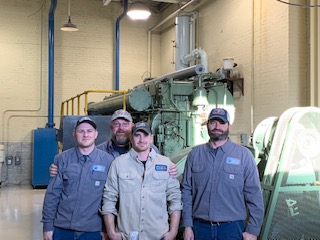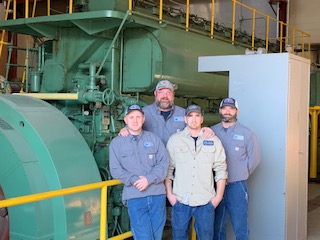Powering Portland: Behind the Scenes at the Department of Power and Light
- Jordan D. Smith
- Dec 23, 2021
- 5 min read
You flip a switch, or plug it in and it comes on. Besides the monthly bill for electricity, you probably don’t give it too much thought, but where does our energy come from? Portland is one of about 40 communities across the state that operates its own independent electric utility. The civil servants of the Portland Department of Power and Light (DPL) literally keep the lights on around here. To understand what they do, we took a look behind the scenes with DPL director Todd Davlin.
From their headquarters on Grand River Ave the DPL operates the city electric grid.
The most noticeable part of that system is the natural gas generators housed at the Grand River Ave facility. Inside three enormous generators powered by natural gas sit idle most of the time. The two largest ones start on diesel before transitioning to natural gas. The smallest runs on diesel alone and essentially is used to start up the other two in case of a large scale power outage. According to Davlin, these generators are used any time demand peaks or the cost of purchasing electricity through the marketplace makes running it economical. This is mostly during the summer months when demand peaks as Portlanders turn on the air conditioning to beat the heat. Besides monthly tests, the most recent time they were used extensively was in the winter of 2021 when large scale power outages in Texas threw the nationwide power supply into disarray driving up costs.
In addition to the natural gas generator station the DPL operates the Portland dam hydroelectric station. The dam on Lyons Road, despite being nearly 100 years old, continues to churn away providing about 10% of the city’s power needs. Inside the brick generator building along the shore two gigantic turbines spin powered by the waters of the Grand River cascading below the building. The dam harkens back to a bygone age when many cities build eclectic plants primarily to provide the need for streetlights. At the time, Davlin says, these dynamos likely powered all the needs of the city which is why the name of the department specifically includes the word light. To this day the DPL maintains the city’s streetlights.
In recent years, there has been a fair concern about dam safety after a catastrophic dam failure in Midland, Michigan. After taking over leadership at the DPL this past summer, Davlin says that is something he wanted to be sure to be proactive about. He says that one of the first things he did was contact the state licensing body that oversees dams to ask for an assessment. They state regulators said, “I don’t worry about your dam,” says Davlin. The dam is low in height meaning that the amount of water behind it is relatively low compared to taller dams like the one that failed in Midland. In addition, the concrete dam is topped with a 2 foot wooden section that is decided to break away in case of flooding to gradually release pressure. The wood structure is routinely repaired and broken boards replaced. Davlin says he and his staff also routinely monitor the earthen embankments along the sides of the dam, which is where many dam failures begin looking for erosion or leakage. This includes regular inspection, mowing and maintenance of vegetation to prevent erosion. Despite this, Davlin says that he isn’t taking any chances on safety and has plans for independent engineers to inspect the dam in early 2022 to give a fresh set of eyes on Portland’s original green energy source. “Since 1896, Portland has been renewable,” Davlin says, and diligent care is important, “so in 100 years we are still making renewable energy.”
Between the dam and natural gas generators about 2/3rds of the power the city needs can be generated locally if needed. Most of the time those generators are not online though and that is where power purchased through the Michigan Public Power Association (MPPA) and transmitted to the DPL by Consumers Energy lines comes in. As members of MPPA, the DPL owns shares in a variety of power generation facilities from solar and wind farms, to coal power plants. This diversified portfolio of power generation ensures stability and reliability, says Davlin.
All told, Portland electricity comes from roughly equal thirds from coal, natural gas, and a mix of renewable sources. That renewable third includes the hydroelectric plant as well as energy purchased through MPPA. In fact just last week, says Davlin, a solar farm the DPL invested in through MPPA came on line. Moving forward, Davlin says that he definitely sees coal phasing out and being replaced with natural gas in the short term and later with expanded solar and wind generation. In fact, several coal plants that the DPL owns shares in through the MPPA have announced plans to shut down in the next 5-10 years. “The price of solar and wind has come down dramatically,” says Davlin. He also anticipates that we will see hydrogen gas will be a big player as it can be used as an energy storage mechanism. Excess solar/wind power can be used to generate hydrogen gas from natural gas or water, which can be stored and cleanly burned to provide electricity when demand peaks.
Besides the power plants, Davlin and his team of linemen oversee and maintain the city’s system of electric lines. Currently about 85% of the city’s lines are underground and each year the DPL works to bury more of the remaining lines. Davlin credits his predecessor, Mike Hyland, with having the foresight to underground the city’s power lines in the 1980s. This underground system has been crucial in maintaining consistent power service in severe weather including the 2015 tornado.
Besides gradual undergrounding of lines, the DPL is also gradually replacing all city streetlights with energy efficient LED bulbs. The department is also working toward upgrading all electric meters to “smart meters” that can be monitored remotely. This provides not only more accurate billing, but also allows maintenance to be targeted to prevent outages by spotting equipment failures before they happen. The department is looking at working with NextEra Energy, a company with many years of experience operating smart electric grids out of Florida to provide technical support and network security. While still in the planning phase once started the meter replacement would likely happen over several months.
Asked about the DPL’s involvement in the city’s development of a fiber optic internet system, Davlin said that this too is still in the planning phase, but that a working session is planned for the first of the year. “As we look at it it does look like it is feasible, but not without challenges,” he said. Those challenges are primarily with the upfront costs of building the infrastructure out. The slow progress on this is because, “we are trying to do our due diligence,” to take care of the resources of the community, said Davlin.
PHOTOS: Jordan Smith, Todd Davlin


































Comments